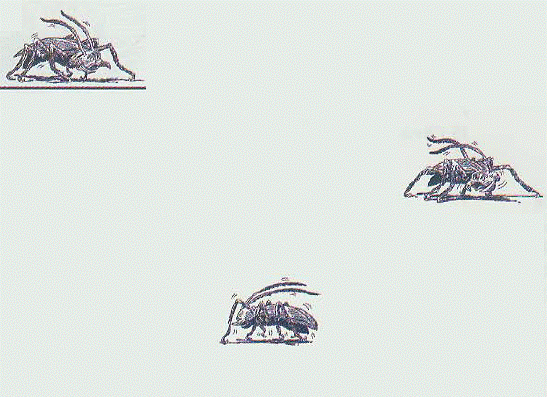
| Standard | Large | Huge | Giant | |
|---|---|---|---|---|
| Climate/Terrain: | Any non-arctic | Any non-arctic | Any non-arctic | Any non-arctic |
| Frequency: | Rare | Rare | Rare | Rare |
| Organization: | Colony | Colony | Colony | Colony |
| Activity Cycle: | Night | Night | Night | Night |
| Diet: | Scavenger | Scavenger | Scavenger | Scavenger |
| Intelligence: | Animal (1) | Animal (1) | Animal (1) | Animal (l) |
| Treasure: | Nil | Nil | Nil | Nil |
| Alignment: | Neutral | Neutral | Neutral | Neutral |
| No. Appearing: | 1-200 | 1-10 | 1-4 | 1 |
| Armor Class: | 8 | 7 | 6 | 5 |
| Movement: | 9 | 12 | 15 | 18 |
| Hit Dice: | 1 hp | 2 | 4 | 6 |
| THAC0: | 20 | 19 | 17 | 15 |
| No. of Attacks: | Nil | 1 | 1 | 1 |
| Damage/Attack: | Nil | 1 | 1-4 | 1-6 |
| Special Attacks: | Disease | Disease | Disease | Disease |
| Special Defenses: | Nil | Scatter | Scatter | Scatter |
| Magic Resistance: | Nil | Nil | Nil | Nil |
| Size: | T (1") | T (18") | S (4') | M (8') |
| Morale: | Unreliable (2) | Unsteady (5) | Average (8) | Steady (11) |
| XP Value: | 7 | 65 | 175 | 420 |
Polyroaches are a magical breed of the common city cockroach able to merge into larger versions of themselves. Each individual polyroach is about an inch long, beetlelike in form with a light brown wing case covering its back, although the wings are vestigial and the creature is incapable of flight. Colonies of polyroachcs can number as high as 200. Twenty polyroaches can pile together and merge their bodies, creating a large polyroach about 18" long. Fifty polyroaches merging together create a huge polyroach measuring 4' in length, while 200 polyroaches can polymorph into a giant polyroach a full 6' long. The transformation takes a full round, but reversion to individual, inch-long roaches is instantaneous.
Regardless of the size of the creature, a polyroach has poor eyesight and relies on its sensitive antennae. The antennae warn the creature of movement around it to a range of 120 feet and allow it to detect edible food (or at least what it considers to be food) within 60 feet. Polyroaches, Like all true roaches, are very quick and can change speed and direction instantly.
Combat: Polyroaches in their standard forms do not attack creatures larger than themselves, thus no THAC0 or damage statistic are given. However, as they merge into larger forms, their mandibles grow stronger, and they can inflict serious damage. Still, polyroaches are primarily scavengers, preferring to eat whatever is already available rather tl1an hunt down live prey, since that type of food has the irritating habit of trying to run away, or, even worse, fight back.
The bite of a polyroach has a 10% chance of spreading a disease similar to those caused by rats. I-lowever, a person needn't be bitten by a polyroach to catch the disease; merely having polyroaches infest a dwelling gives the inhabitants a 5% chance per week of becoming diseased.
If a polyroach of large size or bigger is hard-pressed in a fight, it scatters - that is, it immediately reforms it's body into the many 1" sized roaches, and the smaller roaches scurry away in every possible direction. Every hit point of damage suffered by a bigger polyroach kills one of the standard-sized polyroadies, so when it reverts to the individuals, many of them drop to the floor, dead. If the polyroach's opponent was trying to kill it as a food source, it might be distracted by the dead roaches, allowing those who survived to get away.
Habitat/Society: Polyroaches are scavengers, eating just about anything they can find, including garbage, whitewash, and even the bindings on books. In their smaller sizes, they often infest inhabited buildings, scouring kitchens and storerooms for particles of food. They are almost universally abhorred, as most intelligent beings consider the creatures disgusting.
Polyroaches are active primarily at night, as they dislike bright lights. While llght does not cause them pain, it does cause them to flee. They lair in dark places-basements, crawlspaces, garbage dumps, and the like. In their smaller forms, they often live between the walls of buildings. A single female can lay as many as 400 eggs, so ridding a dwelling of these pests is often a lengthy battle.
Ecology: Polyroaches, as scavengers, are at the bottom of the food chain. While not really formidable foes, the mere sight of a giant-sized cockroach sends many adventurers fleeing in the opposite direction.
To date, no magical use has been found for the polyroach. The creatures might be of interest to those wizards specializing in polymorph-related spells, to learn how the magical merging of multiple creatures is done so quickly and successfully.
